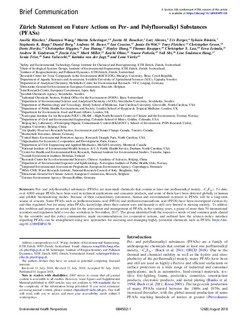Zürich Statement on Future Actions on Per- and Polyfluoroalkyl Substances (PFASs)
| dc.contributor.author | Ritscher, Amélie | |
| dc.contributor.author | Wang, Zhanyun | |
| dc.contributor.author | Scheringer, Martin | |
| dc.contributor.author | Boucher, Justin M. | |
| dc.contributor.author | Ahrens, Lutz | |
| dc.contributor.author | Berger, Urs | |
| dc.contributor.author | Bintein, Sylvain | |
| dc.contributor.author | Bopp, Stephanie K. | |
| dc.contributor.author | Borg, Daniel | |
| dc.contributor.author | Buser, Andreas M. | |
| dc.contributor.author | Cousins, Ian | |
| dc.contributor.author | DeWitt, Jamie | |
| dc.contributor.author | Fletcher, Tony | |
| dc.contributor.author | Green, Christopher | |
| dc.contributor.author | Herzke, Dorte | |
| dc.contributor.author | Higgins, Christopher | |
| dc.contributor.author | Huang, Jun | |
| dc.contributor.author | Hung, Hayley | |
| dc.contributor.author | Knepper, Thomas | |
| dc.contributor.author | Lau, Christopher S. | |
| dc.contributor.author | Leinala, Eeva | |
| dc.contributor.author | Lindstrom, Andrew B. | |
| dc.contributor.author | Liu, Jinxia | |
| dc.contributor.author | Miller, Mark | |
| dc.contributor.author | Ohno, Koichi | |
| dc.contributor.author | Perkola, Noora | |
| dc.contributor.author | Shi, Yali | |
| dc.contributor.author | Haug, Line Småstuen | |
| dc.contributor.author | Trier, Xenia | |
| dc.contributor.author | Valsecchi, Sara | |
| dc.contributor.author | van der Jagt, Katinka | |
| dc.contributor.author | Vierke, Lena | |
| dc.date.accessioned | 2018-10-08T09:00:46Z | |
| dc.date.available | 2018-10-08T09:00:46Z | |
| dc.date.created | 2018-09-27T09:01:07Z | |
| dc.date.issued | 2018 | |
| dc.identifier.citation | Environmental Health Perspectives. 2018, 084502 | nb_NO |
| dc.identifier.issn | 0091-6765 | |
| dc.identifier.uri | http://hdl.handle.net/11250/2566790 | |
| dc.description.abstract | Per- and polyfluoroalkyl substances (PFASs) are man-made chemicals that contain at least one perfluoroalkyl moiety, –CnF2n–. To date, over 4,000 unique PFASs have been used in technical applications and consumer products, and some of them have been detected globally in human and wildlife biomonitoring studies. Because of their extraordinary persistence, human and environmental exposure to PFASs will be a long-term source of concern. Some PFASs such as perfluorooctanoic acid (PFOA) and perfluorooctanesulfonic acid (PFOS) have been investigated extensively and thus regulated, but for many other PFASs, knowledge about their current uses and hazards is still very limited or missing entirely. To address this problem and prepare an action plan for the assessment and management of PFASs in the coming years, a group of more than 50 international scientists and regulators held a two-day workshop in November, 2017. The group identified both the respective needs of and common goals shared by the scientific and the policy communities, made recommendations for cooperative actions, and outlined how the science–policy interface regarding PFASs can be strengthened using new approaches for assessing and managing highly persistent chemicals such as PFASs. | nb_NO |
| dc.language.iso | eng | nb_NO |
| dc.title | Zürich Statement on Future Actions on Per- and Polyfluoroalkyl Substances (PFASs) | nb_NO |
| dc.title.alternative | Zürich Statement on Future Actions on Per- and Polyfluoroalkyl Substances (PFASs) | nb_NO |
| dc.type | Others | nb_NO |
| dc.description.version | publishedVersion | nb_NO |
| dc.source.volume | 126 | nb_NO |
| dc.source.journal | Environmental Health Perspectives | nb_NO |
| dc.identifier.doi | 10.1289/EHP4158 | |
| dc.identifier.cristin | 1614424 | |
| cristin.unitcode | 7460,60,0,0 | |
| cristin.unitname | Miljøkjemi | |
| cristin.ispublished | true | |
| cristin.fulltext | original | |
| cristin.qualitycode | 2 |
Tilhørende fil(er)
Denne innførselen finnes i følgende samling(er)
-
Publikasjoner fra Cristin - NILU [1329]
-
Vitenskapelige publikasjoner [1068]
Vitenskapelige artikler, kapitler og monografier.
